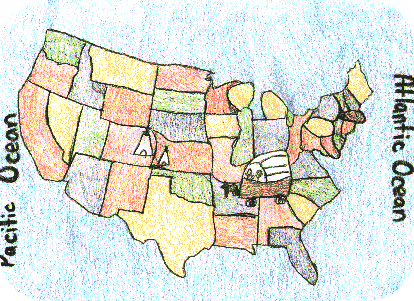Heritage Gateways
Official Sesquicentennial K-12 Education Projectsponsored by the Utah State Board of Education, the BYU-Public School Partnership and the Utah Education Network
Pioneer 1847 Companies
Western Maps Consulted by the Mormons

Image courtesy of: Heritage Gateway Project Images, These images have been gathered to support the Sesquicentennial celebration of the immigration to Utah.
Of far more importance to the Mormons than the travel accounts were the maps available to them. There were many--a plethora in fact." Since at least 1722, dozens of Spanish, French, and American maps had been published showing, in varying degrees of accuracy and fullness, the Platte River area. Over fifty maps of the trans-Mississippi west appeared during the first five years of the 1840s, and in the critical year of 1846 another twenty-eight were published.
From a practical standpoint, there is no use in this study to consider anything published prior to Major S.H. Long's map of 1823, which not only gave details along the north side of the Platte from the Missouri River to the forks of the Platte (see Appendix A, Map 5), but is also generally considered to have been the best map of the Platte area prior to those prepared by Fremont and his cartographer Charles Preuss. (See Appendix A, Map 3.)
It appears the Mormons also consulted the 1835 map of Bonneville. Unfortunately he was an untrained amateur and his map, not based on astronomical observations, was of poor technical quality. Still it was widely known and used in its day.
While there were many maps of the trans-Missouri west published in the 1840s, almost every one the Mormons might have been interested in were either those of Fremont-Preuss or based on Fremont-Preuss. The three Fremont-Preuss maps, which appeared in 1843, 1845, and 1846, were what we would call strip maps today, showing only the area actually explored with no attempt to present wide, general areas. They represent the best American cartography between Long's work and the Civil War.
The first of the Fremont-Preuss series, showing the Oregon Trail in great detail, from the forks of the Platte to South Pass and the Wind River Mountains, was the basis for the two that followed. In large format, 141/2" by 333/4", it was clearly the finest map of that area ever produced. Preuss prepared another map in 1845 to accompany Fremont's second Report of that year. As the 1845 publication included the 1843 material, the 1845 map embodied everything on the 1843 map. In huge format, 51" x 311/2", it showed his route along the Oregon trail from Westport (now part of Kansas City), to South Pass, Fort Vancouver, and on to San Francisco Bay. This map also provided a good sketch of the Platte River west from Bellevue, showing the Elkhorn, Loup, and Wood rivers.
In 1846, Preuss reworked his 1845 map. This map, from Westport to the Columbia River, was constructed on a grand scale of only 10 miles to the inch and was issued in seven sections, each 26" by 16.11
Of those maps derived from Fremont-Preuss, which the Mormons may have also consulted, are products that appeared with the 1845 Report of Colonel S. Kearny's expedition from Fort Leavenworth to South Pass; the 1845 Charles Wilkes Map of Oregon Territory; Rufus B. Sage's 1846 Map of Oregon, California, New Mexico and Northwest Texas; and above all, one or more of the three maps published by S. Augustus Mitchell in 1846. It was one or more of these Mitchell maps that Young ordered from St. Louis during January 1846, as cited previously. The map in question was undoubtedly the previously mentioned, "A New Map of Texas, Oregon, and California," which was 20" by 22" and appeared in four colors. (See Appendix A, Map 4.) It would seem then that the maps that hung on the walls of the Nauvoo temple and that were subsequently taken west, besides Fremont's, were surely Mitchell's, Wilkes" , Bonneville's, and most likely Long's. Unfortunately none of the copies used by the pioneers has survived.
Source: Historic Resource Study - Mormon Pioneer National By Stanley B. Kimball, Ph.D., May 1991. (The study focuses on the history of the trail from its official beginning in Nauvoo, Illinois, to its terminus in Salt Lake City, Utah, during the period 1846-1869. During that time, thousands of Mormon emigrants used many trails and trail variants to reach Utah. This study emphasizes the "Pioneer Route" or "Brigham Young Route" of 1846-1847. The sections on Mormon beliefs and motivations for going west have been omitted. Interested persons can find ample sources for that information. The footnotes, bibliography, maps, pictures, pioneer companies by name and dates for the 22-year period, and historic sites - about 2/3 of the book - have also been left out for space considerations. Thanks to Dr. Kimball and the National Park Service for the availability of this information.)